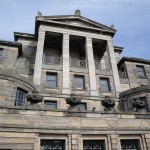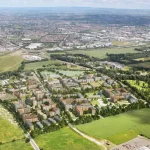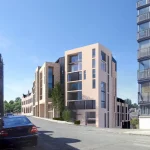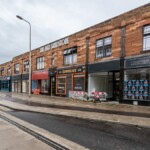The Future of Scotland’s Architecture, Edinburgh Building Heritage, Conservation
Future Scottish Architecture
Conservation v Evolution : The Big Debate
1 Dec 2001
Future of Scotland’s Architecture
Future of Scotland’s Architecture : Conservation v Evolution
Review of the Debate on 30 Nov 2001
Big Debate Review – by Isabelle Lomholt
Big Debate Hub – by Adrian Welch
Big Debate PR
The Royal Incorporation of Architects in Scotland
Article from Irish Times 24/1/2002 by Frank McDonald
Historic Scotland defends its staunch position
What is it about the Scots that makes them so outspoken? Frank McDonald, Environment Editor, found out at a recent clash between architects and conservationists in Edinburgh.
Few if any professionals in Ireland are prepared to get up on a public platform and openly criticise anyone in a position of power. The old adage “You’ll never work in this town again” is still a powerful constraint that inhibits real debate about the direction of public policy here.
Not so in Scotland. The Scots have no such inhibitions, judging by the remarkably outspoken views expressed at a recent conference entitled “Conservation versus Evolution: The Big Debate”, organised by the Royal Incorporation of Architects in Scotland (RIAS) and held at The Hub, near Edinburgh Castle.
This forthright level of discourse is reflected by Prospect, the bi-monthly journal published in association with the RIAS. It provides a lively forum for opinion on the issues of the day, by contrast with the dry and sometimes dreary accounts by architects of their own buildings that fill the RIAI’s Irish Architect.
The Hub, a mid-Victorian church designed by Pugin, is a startling example of the conversion of historic buildings to new uses – in this case, a multi-purpose conference facility and venue for the Edinburgh Festival. Its interior, repainted in garish Day-Glo colours, was described by one speaker as “Pugin on acid”.
It was a metaphor for the theme of the one-day RIAS conference, which revolved around the contentious issue of how contemporary architecture can be achieved in a city like Edinburgh, much of which is a World Heritage site, and whether architects there are being hog-tied by a powerful conservation lobby.
The main target of their spleen was Historic Scotland, the quango charged with vetting proposals for alterations to listed buildings. Dubbed Hysteric Scotland by its critics, it has raised architectural hackles by vetoing visionary plans for modern interventions, such as re-roofing ruined Linlithgow Castle.
Though the conference organiser, John Pelan, had been accused of “stirring things up”, he said the aim was to “resolve some of the very real problems about how to move on” so that Scotland could develop as a culturally confident country, proud of its built heritage “but not constrained by it”. According to architect James Simpson, Historic Scotland is staffed by “busy functionaries with strong opinions” who showed “arrogance, presumptiveness and a lack of respect for the views of outsiders”. It put too much emphasis on historical value over architectural merit and reduced planning to a “box-ticking exercise”.
As in Ireland, 50 per cent of planning applications in Scotland are made by non-architects. Architects, as Simpson said, “like to be at the best parties” and want to build in the most desirable places. Conservation should mean “making the most of what we’ve got”, remembering that a building finished last week is a historic building.
Charles McKean, professor of Scottish architectural history at Dundee University, complained that the conservation czars would prefer to freeze venerable historic buildings such as Linlithgow Castle in “a state of ruination” rather than permit an “act of the imagination” that would return them to viable use.
To him, Historic Scotland is “severely flawed and getting worse”. It had fixed views based in archaeology and was “not talking to us”. As a result, architects were “forced to drop contemporary ideas”, and he warned that Scotland would be seen as “a nerveless country” if all it did was preserve the past.
Prof McKean contrasted this with the “sense of freedom” on the European mainland, where contemporary interventions that showed some empathy with the fabric of a historic building were permitted, even encouraged. But it was a “good thing” that architecture had finally become “fashionable” among the chattering classes.
Richard Murphy, one of Scotland’s most flamboyant practitioners, described Edinburgh as “a tough city to be an architect in”. But in his somewhat low-key address, he argued that it was “better to preserve fragments of history and create an imaginative whole” rather than adopt the strictly archaeological approach.
The title of Murphy’s talk was “Let’s not be beastly to Richard Emerson” – an amusing reference to Historic Scotland’s chief inspector. Emerson, an urbane and humorous man who proved well able to defend his patch, joked that the original title Murphy had in mind was “Let’s be beastly to Richard Emerson”.
The central charge against Historic Scotland was “seriously silly”, he declared. Though some regarded architecture as “not a matter of life and death but something more important” and believed that no listed building should be exempt from “witty interventions”, they had to recognise the city as a work of art.
“The creation of good buildings should not require the destruction of good buildings,” Emerson told the conference. There was also “no evidence” that Historic Scotland had obstructed Richard Murphy’s work, even though much of it involved additions or alterations to historic buildings. Edinburgh’s Old Town wouldn’t have survived at all if master-planner Patrick Abercrombie had got his way, as Terry Levinthal, of the Scottish Civic Trust, pointed out. All that would have been left of it was a few prominent buildings, such as the castle; the tall, grey tenements lining its streets would all have been demolished.
But the conservation lobby had seen off that dastardly plan and much of the destruction planned for the Georgian New Town, too. One of the crucial factors that protected it was that the New Town had never been deserted by Edinburgh’s professional class in the way that Georgian Dublin was abandoned in the 1960s.
Now the city was left with a “contrived legacy of planning and design mediocrity” according to Levinthal. “Architecture is seen as a symbol of macho virility and conservation as a sort of emasculation.” Yet surveys of visitors to historic buildings found that 63 per cent believed modern architecture contributes to the built environment.
That is confirmed by the positive public reaction to the contextually modernist Museum of Scotland, designed by Benson and Forsyth, architects of the new wing of the National Gallery in Dublin. But the acid test of the public’s appetite for challenging architecture will be the late Enric Miralles’ Scottish Parliament.
Murray Grigor, award-winning documentary film-maker, didn’t flinch from attacking the “cultural hooliganism” of BBC Scotland, saying it had never made a programme on the new Parliament building, now under construction at the end of Edinburgh’s Royal Mile after it was nearly aborted because of spiralling costs. It may not be in the same class, but “what price the Sydney Opera House?” asked Sir James Dunbar-Nasmith, who has been in the thick of things for nearly 50 years. Good buildings were the best advertisement for architects and architecture, so “quality in everything we do” should always take precedence over money.
But what hope is there for “culture” when James Boyle, president of the Scottish Arts Council, could characterise Alexander Thompson’s Caledonian Church in Glasgow’s Gorbals as a “ghastly cadaver”? Outspoken, yes, but ignorant. As Murray Grigor noted, Thompson was one of the pioneers of innovative architecture in Scotland.
The Future of Scotland’s Architecture
“The Big Debate will feature some of Scotland’s leading figures from the architecture, arts, planning, conservation and construction worlds”.
RIAS @ The Hub, Castlehill, Edinburgh
Speakers & Titles:
| Professor Charles McKean | False Oppositions |
| Murray Grigor | Historical Kitsch |
| James Simpson | Let us have real architecture! |
| Terry Levinthal | Nero fiddles… |
| Sir James Dunbar-Nasmith | The Big Debate of the phoney war? |
| Richard Emerson | Say hello to the Zeitgeist |
| Richard Murphy | Let’s not be beastly to Richard Emerson |
| Frank McDonald | The Construction of Dublin |
| Ian Begg | Vive la difference |
| Malcolm Fraser | Corduroy trousers, stainless steel bicycle clips |
Edinburgh Walking Tours : Architecture Walking Tours
Comments / photos for the Future of Scotland’s Architecture page welcome
Future Scottish Architecture Building : page



